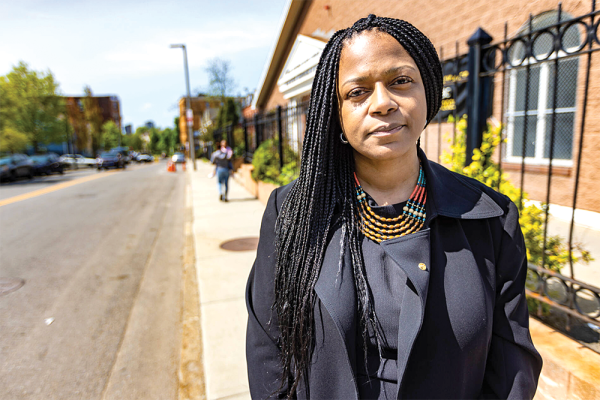May 18, 2023

Dr. Bisola Ojikutu, executive director of the Boston Public Health Commission. WBUR photo
People living in Dorchester and Mattapan are disproportionately impacted by cancer, heart disease, and diabetes compared to other parts of Boston, according to a new report prepared by the Boston Public Health Commission (BPHC), which hopes to get more people screened and treated for conditions that can lead to preventabl early deaths.
Dr. Bisola Ojikutu, executive director of the BPHC and a Dorchester resident, said that while there were some very positive health trends citywide, there were “persistent disparities between demographic groups and neighborhoods” like Dorchester and Mattapan.
“Overall, things like cancer mortality rates citywide have decreased by the numbers, but when you zoom in and look at race and ethnicity, that’s where you see these disparities,” she told the Reporter.
The report zeroes in on indicators of health citywide, demographically, and in each neighborhood. Chronic conditions like asthma, cancer, diabetes, heart disease, along with life expectancy and mortality rates are included in the study.
Ojikutu noted that most causes of premature mortality – defined as a death before age 65 – were overdoses, cancer, heart disease, Covid-19, and diabetes.
“In 2021, premature mortality rates were two times as high in those living in zip codes in Dorchester versus those living in Back Bay/Downtown/Beacon Hill, which are all three measured together,” Ojikutu told the Reporter. “The mortality rates are more than two times higher in Mattapan.”
While overdoses were the number one cause of early deaths citywide, Ojikutu said, that data has not yet been broken down by specific neighborhood. But many of the conditions, she said, could be prevented with a return to regular screenings and better access to health care.
“Covid separated so many people from the health care system and re-integrating them into the system is so important now,” she noted. “There are a lot of people who need to catch up on screenings, things like colonoscopies and prostate cancer checks. We have ground to cover in re-engaging people, particularly people who may have already been marginalized before Covid by factors like socio-economic status or a being in a large immigrant population that isn’t familiar with the US healthcare system.”
According to BPHC data, Mattapan’s top cause of early death in 2020 was Covid-19. “In all previous years, it was also cancer,” Ojikutu said. “In 2021, it switched back and cancer was again the leading cause of mortality in Mattapan …I think what I would focus on is the pieces related to cancer mortality because that’s someplace where we could potentially intervene.”
She emphasized again that it is crucial to get residents in the neighborhoods connected to community health centers for screenings and preventative care.
“A lot of these cancers are preventable,” she said, noting prostate, lung, liver, and colon cancer. “I try not to point the finger at any one thing. It’s complicated but we want to make sure we have people armed with the knowledge of how to prevent these cancers and how to get access to screenings.”
Charley Murphy, director of the Harvard Street Neighborhood Health Center on Blue Hill Avenue, called Ojikutu’s comments “spot on.” Harvard Street has seen a similar drop-off in screenings, testing, and preventative care since Covid-19. To remedy that, they have instituted weekly patient outreach.
“It starts to get out of peoples’ routine,” he said. “We’ve been making an effort to do active outreach to patients and people we usually see, especially chronic care folks like patients with diabetes…It has to be a consistent and concerted effort and we’re making that effort with outgoing phone calls at least once a week.”
Murphy said their numbers also confirm what the BPHC is seeing, a drop off in preventative care. But in recent months, the reminders have produced an uptick in patients returning for screenings and physicals.
“It can’t be a one-off; we are doing this every week,” he said.
Like with cancer, the same story was true for diabetes and heart disease in the BPHC report. Mattapan had the highest age-adjusted heart disease mortality rate and Back Bay had the lowest. For diabetes in particular, Dorchester and Mattapan were in the top five citywide for prevalence of diabetes in the population. For age-adjusted diabetes hospitalization rates, Mattapan was the highest in the city, and Dorchester’s 02122 and 02124 zip codes were second and third. Mortality rates for diabetes were also highest in Mattapan, and Dorchester’s zip codes were third and fourth highest.
Citywide, diabetes mortality rates for Black women were 3.3 times higher than for white women, and 2.8 times higher for Black men than white men.
Ojikutu said there are a lot of things that can be done from a medical perspective, like helping to maintain a healthy body weight, avoiding sugars and saturated fats, and increasing physical activity. However, there are also non-medical factors at play in neighborhoods like Dorchester and Mattapan that work against these measures.
“It’s not just that the space is there to use for physical activity, but that people need to feel comfortable that going out there won’t cause them harm in other ways,” she said. “It really is these neighborhoods factors that predict mortality and premature mortality and life expectancy across Boston and our country as well.”
She said asthma is a particular challenge for young people in Dorchester and Mattapan. Emergency room visits for asthma were highest in Mattapan, with Roxbury and Dorchester right behind. West Roxbury had the lowest asthma rates in the city (15 per 10,000 residents) and Mattapan had the highest rates (144.1 per 10,000). Additionally, Asian and LatinX Boston Public Schools (BPS) students were 30 percent more likely to visit the emergency room for asthma, and Black students were 28 percent more likely, than white students enrolled in BPS.
Ojikutu said people often point exclusively to environmental pollution when it comes to asthma rates, but she noted there is more to consider.
“Asthma is complicated,” she said. “It certainly can be about the external environment, but it’s also about our living environment – old rugs, indoor air quality, mold and other things like pests and rodents that also can trigger asthma reactions.”
She said there are programs like the Asthma Home Visit Program to help mitigate triggers inside the home, and the Breath Easy at Home program that works with landlords to make repairs that will improve conditions inside apartments for those with asthma. Finally, she said, older adults need to re-engage in social circles and be in contact with people again. So many, she said, have become very isolated and that has a direct result on life expectancy for older adults.
“For older adults, some can’t physically get out, and some of them may not want to leave and that may be something to look at regarding depression and anxiety,” she said. “I think connecting with community health workers and community health centers is important to re-engage people in social environments so they can talk to people or just be around people…I advise all of my older patients and even my parents to get out and socialize.”



